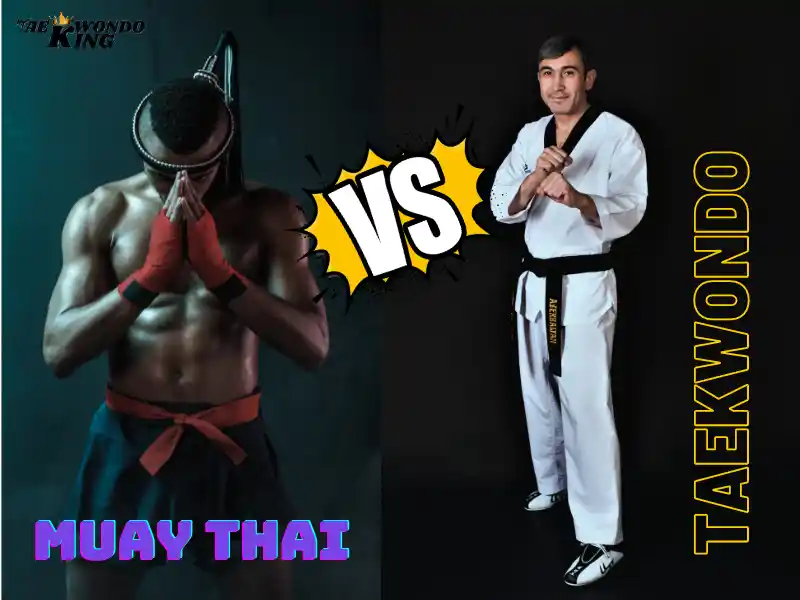
Muay Thai vs. Taekwondo is a hotly debated topic among martial artists. Which is better? And who would win? We’ve put it to the test. Do you know which martial arts will give you a faster and more effective workout? Find out today. Here are the top 10 reasons why we’ve decided that the title of the best sport is Taekwondo.
Muay Thai is a traditional, indigenous fighting art from Thailand that focuses on striking techniques and grappling. Taekwondo is the Korean counterpart to Muay Thai. Both are forms of martial arts that focus on self-defense, but they are very different in style.
You’re probably familiar with both martial arts techniques, but did you know there are some key differences between the two? In this article, we’ll break down the differences and explain why these styles of martial arts have different goals.
What are the main differences between Muay Thai vs Taekwondo?
While the two disciplines look different on the surface, there are actually a number of similarities between them. For starters, both disciplines feature kicks, punches, knees, elbows, and strikes using the fist and hands.
Both include basic conditioning exercises. Taekwondo is a bit more physical than Muay Thai, but they both require balance and flexibility in the legs and feet. Also, both disciplines incorporate aspects of self-defense into their training.
While the two styles can be practiced in a non-sporting setting, you’re likely going to be fighting people who’ve trained in the specific style (which can sometimes lead to injuries). Muay Thai focuses on low kicks, punches, knees, and elbows, while Taekwondo focuses on many types of kicks, high kicks, jumping kicks, and spinning kicks. Taekwondo has more safety and body safety equipment than Muay Thai.
Are there any advantages to choosing one over Muay Thai vs. Taekwondo?
Both Muay Thai and Tae Kwon Do offer a lot of similar physical training. Each of these sports requires some combination of kicking, punching, pulling, pushing, jumping, and rolling. And although Muay Thai and Tae Kwon Do may seem very similar on paper, they’re far from the same. While both Muay Thai and Tae Kwon Do focus on conditioning and strength, there are significant differences between the two. Muay Thai is an art form, while Tae Kwon Do is a set of techniques with rules.
There are a lot of benefits to choosing one martial art over another, such as the obvious fact that one may be more accessible to beginners than another. But, it’s also important to consider the mental, physical, and spiritual aspects that are associated with each martial art.
While the mental aspect of martial arts isn’t as important when learning an art for self-defense, the spiritual aspect is crucial in developing self-discipline and character, which will lead to personal development. The answer depends on what kind of martial art you prefer, but there is no downside to choosing either one of these fighting styles. In fact, both of them offer a unique set of advantages, depending on your preferences.
Both require years of dedicated training, but one takes more time and effort than the other. While each of them offers a unique set of physical benefits, some people like taekwondo better for the flexibility it provides and others prefer Muay Thai.
Muay Thai vs Taekwondo? Are there any disadvantages to choosing one?
There are many advantages to choosing one over the other, including that Muay Thai is easier to learn, more popular, and requires less equipment than taekwondo. However, one disadvantage to choosing Muay Thai is that it’s not always taught or practiced in a traditional sense. Most people who choose Muay Thai don’t train with gloves and pads like a traditional martial arts practitioner would. This often leads to accidents when sparring and kicking people, which can lead to injuries.
In addition to having more options than traditional martial arts, there are a couple of drawbacks to Muay Thai. First, Muay Thai is a full-contact sport that includes a lot of punches, kicks, knees, and elbows. Although the risk of serious injury is low, it’s still something to consider if you don’t want to injure yourself. Second, Muay Thai requires a lot of sparring practice. Most people don’t spend the time necessary to learn it; however, Taekwondo can be a fun sport to learn, especially if you enjoy practicing against an imaginary opponent.
In conclusion,

The answer to the question is very simple. The only thing that separates the two disciplines is the fact that the techniques used in one are not suitable for the other. The most obvious difference between the two is the use of fists and punches in Muay Thai and kicks in Taekwondo. This is because, in Muay Thai, a practitioner uses his fist to strike an opponent, whereas, in Taekwondo, a practitioner uses his kicks to strike an opponent.
Muay Thai is more effective than Taekwondo in most aspects of the sport. This is because of the differences between Muay Thai and Taekwondo sparring techniques and their relative fighting styles. When sparring in both martial arts, both fighters have their strengths and weaknesses. Both techniques include kicks to the head, and elbows, knees, and body punches.
While Taekwondo emphasizes a longer-range striking style, Muay Thai focuses more on close-range kicks, and the ability to break a bone in a vital area. This makes Muay Thai the more versatile, more effective martial art for combat sports. Now the choice is yours. Which martial is the best?
FAQs
What can you achieve with Muay Thai and Taekwondo training?
By training in Muay Thai and Taekwondo, you can experience a wide range of physical and mental benefits. These martial arts disciplines can enhance your strength, flexibility, balance, and coordination. They also equip you with effective self-defense techniques and contribute to increased confidence and discipline. Moreover, practicing Muay Thai and Taekwondo can enhance your cardiovascular fitness and overall endurance.
Which martial art is better for self-defense: Muay Thai or Taekwondo?
Both Muay Thai and Taekwondo are effective martial arts for self-defense, but they have different focuses and techniques. Muay Thai is known for its powerful strikes using fists, elbows, knees, and shins, and it also includes clinching and grappling techniques. Taekwondo, on the other hand, emphasizes high kicks and fast, spinning strikes. Ultimately, the effectiveness of a martial art for self-defense depends on various factors such as the practitioner’s skill level, physical attributes, and the specific situation. It is recommended to try out both martial arts and see which one suits you best.
How long does it take to achieve a black belt in Muay Thai?
The amount of time it takes to earn a black belt in Muay Thai can differ based on an individual’s commitment, frequency of training, and level of skill. Typically, it requires several years of regular training and practice to attain the black belt rank in Muay Thai.
How long does it take to achieve a black belt in Taekwondo?
The amount of time required to obtain a black belt in Taekwondo can vary depending on the person and their training program. Typically, it takes about 2 to 5 years of regular training and commitment to reach the black belt level. However, this timeframe can differ depending on factors such as how often one trains, their personal progress, and the specific guidelines set by the Taekwondo school or organization.
What are the benefits of practicing Taekwondo and Muay Thai?
The benefits of practicing Taekwondo and Muay Thai include improved physical fitness, coordination, flexibility, self-defense skills, mental focus, discipline, confidence, self-esteem, stress relief, competition opportunities, and personal growth. Both martial arts also foster a sense of community and camaraderie among practitioners.

Founder, Owner, and CEO of TaekwondoKing.
He is one of the top 100 martial artists in the World and among the top 20 referees in Bangladesh.
Ehatasamul Alom is an esteemed Kukkiwon Certified Taekwondo 3rd Dan Black Belt with over 15 years of experience in this dynamic martial art. Born in Rajshahi, Bangladesh, Ehatasamul’s journey with Taekwondo began at the tender age of seven. His passion led him to compete at national and international levels, where he has bagged numerous awards and honors. He is also a member of the Taekwondo National Referee Panel.
With a Bachelor’s degree in Sports Science from the prestigious Rajshahi University, Ehatasamul has a deep understanding of the technical and scientific aspects of martial arts and some other martial arts.
In 2022, Ehatasamul created the “TaekwondoKing.com” blog to share his knowledge and Real experiences. His articles focus on Taekwondo training techniques, competition strategies, and the art’s rich history and philosophy. He also writes about the importance of mental fortitude and discipline, key aspects of his teaching philosophy. His goal is to inspire both beginners and seasoned practitioners worldwide through insightful and engaging content.
If you need any help, contact Ehatasamul Alom at any time.





Hi to every body, it’s my ffirst visit of this weblog; this weblog contains amazing and
really good stuff designed ffor visitors.